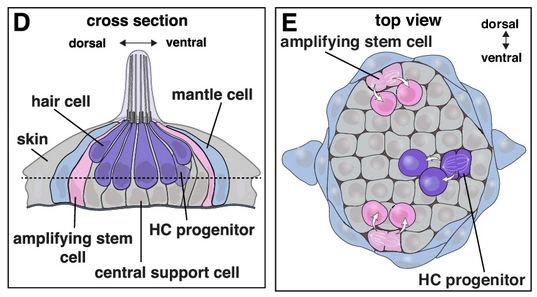By Nicole Laffan, Au.D., M.S., CCC-A/SLP
This Thanksgiving holiday many of us will be gathering with our extended family for the first time in many months, if not a year. Facilitating good communication so we can really connect with one another will be even more important.
Photo by Jeremy Stewardson on Unsplash.
Some of our relatives may be using hearing devices to help them hear. But while hearing technology (e.g., hearing aids, middle ear implants, cochlear implants) may fix the measurement of hearing loss on paper, it does not 100 percent fix the ability to successfully communicate.
Auditory (aural) rehabilitation, paired with properly fit amplification, does. Auditory rehabilitation is a medically necessary part of hearing health. Unfortunately, most patients do not receive it.
Auditory rehab is therapeutic training that focuses on eliminating or minimizing communication difficulties by teaching the listener vital skills to communicate. The speaker can also benefit, as auditory rehab is the missing piece for improving the ability to communicate, with or without amplification.
Successful Communication
Successful communication can be compared to playing a game of catch. In a communication exchange there is a sender of the message (the speaker) and a receiver of the message (the listener). In a game of catch, there is a thrower and a catcher. Both the thrower and the catcher are required to work together to make the game thrive. If the thrower tosses the ball without gaining the catcher’s attention, making sure the catcher is ready, or throwing it within the adequate distance, then the ball will not be caught.
Likewise, if the speaker fails to gain the listener’s attention, does not wait until the listener is ready (for example, until they’ve turned the television down), or is not within an adequate distance, such as facing each other in the same room, then the message will not be caught and the ball— the message—will be dropped.
Often the burden is placed on the listener to catch every message, even the ones that were shared as the speaker turned away from the listener, spoken as they were doing the dishes with the water running and the silverware clanking, or shouted from another floor of the house, etc.
When the speaker learns simple tips and has opportunities to practice them and problem solve common issues, then positive communication changes blossom.
For the listener, auditory rehab focuses on improving their ability to use lipreading/speechreading skills, anticipatory strategies, environmental modifications, techniques to advocate for themselves, and repair strategies for when communication breakdowns occur. The listener is encouraged to work like a detective, analyzing the message from multiple modes: hearing, vision, cognition, and experience. This encourages the listener to play an active role in receiving the message.
If they rely solely on the auditory message, without using other cues, then they are choosing to be a passive player waiting for the broken message and hoping they catch it correctly.
How to Talk to People With Hearing Loss
“How to Talk to People With Hearing Loss” is the book I recommend most to patients with hearing loss and their family members. It is a practical, cohesive guide full of valuable tips. Mary Florentine, Ph.D., and her coauthors impressively share information about hearing loss in an uncomplicated manner. Not only does it share empowering strategies for the listener, but it also enhances their communication partners’ understanding of the challenges the listener faces and the simple adjustments the speaker can implement to make the communication exchange successful.
I reference it weekly, especially the chapter “10 Tips for Effective Communication,” when I host complimentary auditory rehab training sessions as part of the Better Listening Program at Northeastern University in Boston.
I encourage patients to use all methods such as auditory, visual, knowledge about the topic and speaker, and context clues to put the puzzle together and form the most educated guess regarding what might have been said.
10 Tips for Effective Communication
1. Please get my attention before you start speaking to me.
2. Speak slowly and clearly. A moderate pace works best.
3. Look at me, take your hands away from your mouth, and don’t exaggerate your pronunciation.
4. Don’t raise your voice too loud; moderately loud is best.
5. If you are going to change the topic, tell me.
6. If I do not hear you the first time, repeat with different words. Don’t say the same word I did not hear over and over again.
7. Try to limit or avoid background noise. I do not hear well in noisy environments.
8. Talk to me on the side of my better ear.
9. Gestures help me, but don’t be too extreme.
10. Hearing under adverse conditions can be exhausting. Sometimes, I need a break.
Nicole Laffan, Au.D., M.S., CCC-A/SLP, is an assistant clinical professor in communication sciences and disorders at Boston’s Northeastern University; a practicing audiologist and speech language pathologist at Northeastern’s Speech, Language, and Hearing Center; and the chair of the Massachusetts Board of Registration of Speech Language Pathology and Audiology. An excerpt from “How to Talk to People With Hearing Loss” by Mary Florentine, Ph.D., Julia B. Florentine, and Michael J. Epstein, Ph.D., appeared in the Summer 2019 issue of Hearing Health magazine. For more, see glistentraining.co.uk/book.








Before I discovered CART, I often felt left out, despite being physically present. This gap in awareness affects thousands of people. That’s why I speak up, because access delayed is opportunity denied.